 | –≠–ª–µ–∫—Ç—Ä–æ–Ω–Ω—ã–π –∫–æ–º–ø–æ–Ω–µ–Ω—Ç: OPA552 | –°–∫–∞—á–∞—Ç—å:  PDF PDF  ZIP ZIP |
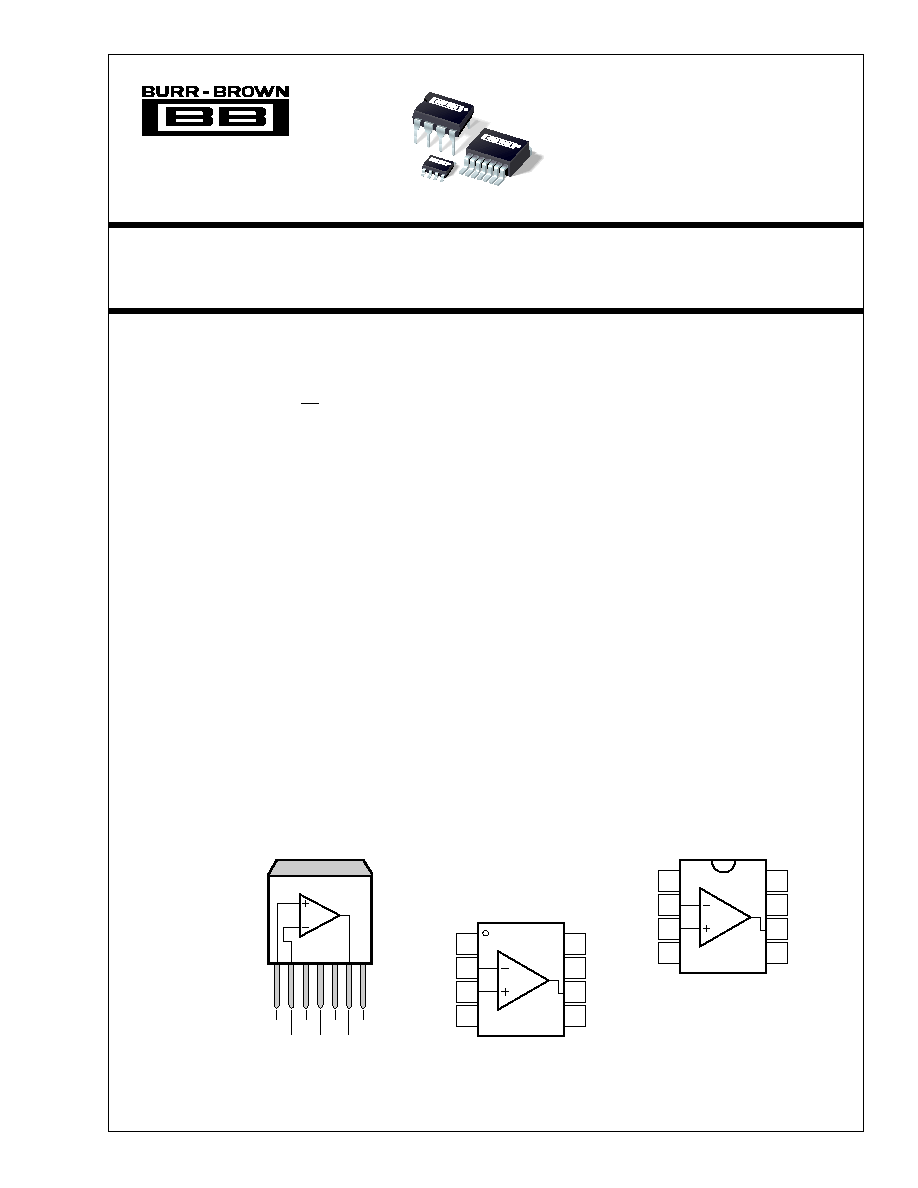
1
OPA551, OPA552
Æ
Æ
OPA551
OPA552
©
1999 Burr-Brown Corporation
PDS-1472A
Printed in U.S.A. July, 1999
High-Voltage, High-Current
OPERATIONAL AMPLIFIERS
DESCRIPTION
The OPA551 and OPA552 are low cost op amps with
high-voltage (60V) and high-current (200mA) capa-
bility.
The OPA551 is unity-gain stable and features high
slew rate (15V
µ
s) and wide bandwidth (3MHz). The
OPA552 is optimized for gains of 5 or greater, and
offers higher speed with a slew rate of 24V/
µ
s and a
bandwidth of 12MHz. Both are suitable for telephony,
audio, servo, and test applications.
These laser-trimmed, monolithic integrated circuits
provide excellent low-level accuracy along with high
output swing. High performance is maintained as the
amplifier swings to its specified limits.
The OPA551 and OPA552 are internally protected
against over-temperature conditions and current over-
loads. The thermal shutdown indicator "flag" provides
a current output to alert the user when thermal shut-
down has occurred.
The OPA551 and OPA552 are available in DIP-8 and
SO-8 packages, as well as a DDPAK-7 surface-
mount plastic power package. They are specified for
operation over the extended industrial temperature
range, ≠40
∞
C to +125
∞
C.
FEATURES
q
WIDE SUPPLY RANGE:
±
4V to
±
30V
q
HIGH OUTPUT CURRENT: 200mA Continuous
q
LOW NOISE: 14nV/
Hz
q
FULLY PROTECTED:
Thermal Shutdown
Output Current-Limited
q
THERMAL SHUTDOWN INDICATOR
q
WIDE OUTPUT SWING: 2V From Rail
q
FAST SLEW RATE:
OPA551: 15V/
µ
s
OPA552: 24V/
µ
s
q
WIDE BANDWIDTH:
OPA551: 3MHz
OPA552: 12MHz
q
PACKAGES: DIP-8, SO-8, or DDPAK-7
APPLICATIONS
q
TELEPHONY
q
TEST EQUIPMENT
q
AUDIO AMPLIFIER
q
TRANSDUCER EXCITATION
q
SERVO DRIVER
International Airport Industrial Park ∑ Mailing Address: PO Box 11400, Tucson, AZ 85734 ∑ Street Address: 6730 S. Tucson Blvd., Tucson, AZ 85706 ∑ Tel: (520) 746-1111
Twx: 910-952-1111 ∑ Internet: http://www.burr-brown.com/ ∑ Cable: BBRCORP ∑ Telex: 066-6491 ∑ FAX: (520) 889-1510 ∑ Immediate Product Info: (800) 548-6132
OPA551
OPA551
OPA551
For most current data sheet and other product
information, visit www.burr-brown.com
1
2
3
4
8
7
6
5
Flag
V+
Out
V≠
V≠
≠In
+In
V≠
OPA551, OPA552
SO-8 (U)
1
2
3
4
8
7
6
5
Flag
V+
Out
NC
NC
≠In
+In
V≠
OPA551, OPA552
DIP-8 (P)
NOTE: Tab is
connected to
V≠ supply.
NC
V≠
V+
Out
+In
≠In
1 2 3 4 5 6
Flag
7
DDPAK-7 Surface-Mount (F)
OPA551, OPA552

2
OPA551, OPA552
Æ
SPECIFICATIONS: V
S
=
±
30V
OPA551
At T
J
= +25
∞
C
(1)
, R
L
= 3k
connected to ground and V
OUT
= 0V, unless otherwise noted.
Boldface limits apply over the specified junction temperature range, T
J
= ≠40
∞
C to +125
∞
C.
OPA551UA, PA, FA
PARAMETER
CONDITION
MIN
TYP
MAX
UNITS
OFFSET VOLTAGE
Input Offset Voltage
V
OS
V
CM
= 0V, I
O
= 0
±
1
±
3
mV
T
J
= ≠40
∞
C to +125
∞
C
±
5
mV
vs Temperature
dV
OS
/dT
±
7
µ
V/
∞
C
vs Power Supply
PSRR
V
S
=
±
4V to
±
30V, V
CM
= 0V
10
30
µ
V/V
INPUT BIAS CURRENT
Input Bias Current
I
B
±
20
±
100
pA
Input Offset Current
I
OS
±
3
±
100
pA
NOISE
Input Voltage Noise Density, f = 1kHz
e
n
14
nV/
Hz
Current Noise Density, f = 1kHz
i
n
3.5
fA/
Hz
INPUT VOLTAGE RANGE
Common-Mode Voltage Range
V
CM
(V≠) + 2.5
(V+) ≠ 2.5
V
Common-Mode Rejection Ratio
CMRR
≠27.5V
< V
CM
< +27.5V
92
102
dB
INPUT IMPEDANCE
Differential
10
13
|| 2
|| pF
Common-Mode
10
13
|| 6
|| pF
OPEN-LOOP GAIN
Open-Loop Voltage Gain
A
OL
R
L
= 3k
, ≠28V < V
O
< +28V
110
126
dB
T
J
= ≠40
∞
C to +125
∞
C
R
L
= 3k
, ≠28V < V
O
< +28V
100
dB
R
L
= 300
, ≠27V < V
O
< +27V
120
dB
FREQUENCY RESPONSE
Gain-Bandwidth Product
GBW
3
MHz
Slew Rate
SR
G = 1
±
15
V/
µ
s
Settling Time: 0.1%
G = 1, C
L
= 100pF, 10V Step
1.3
µ
s
0.01%
G = 1, C
L
= 100pF, 10V Step
2
µ
s
Total Harmonic Distortion + Noise, f = 1kHz
THD+N
V
O
= 15Vrms, R
L
= 3k
, G = 3
0.0005
%
V
O
= 15Vr ms, R
L
= 300
, G = 3
0.0005
%
Overload Recovery Time
V
IN
∑ Gain = V
S
1
µ
s
OUTPUT
Voltage Output
V
OUT
I
O
= 200mA
(V≠) + 3.0
(V+) ≠ 3.0
V
T
J
= ≠40
∞
C to +125
∞
C
I
O
= 200mA
(V≠) + 3.5
(V+) ≠ 3.5
V
I
O
= 10mA
(V≠) + 2.0
(V+) ≠ 2.0
V
T
J
= ≠40
∞
C to +125
∞
C
I
O
= 10mA
(V≠) + 2.5
(V+) ≠ 2.7
V
Maximum Continuous Current Output: dc
I
O
Package Dependent--See Text
±
200
mA
Short-Circuit Current
I
SC
±
380
mA
Capacitive Load Drive
C
LOAD
Stable Operation
See Typical Curve
SHUTDOWN FLAG
Thermal Shutdown Status Output
Normal Operation
Sourcing
0.05
1
µ
A
Thermally Shutdown
Sourcing
80
120
160
µ
A
Voltage Compliance Range
V≠
(V+) ≠ 1.5
V
Junction Temperature
Shutdown
160
∞
C
Reset from Shutdown
140
∞
C
POWER SUPPLY
Specified Voltage
V
S
±
30
V
Operating Voltage Range
±
4
±
30
V
Quiescent Current
I
Q
I
O
= 0
±
7
±
8.5
mA
T
J
= ≠40
∞
C to +125
∞
C
±
10
mA
TEMPERATURE RANGE
Specified Range
T
J
≠40
+125
∞
C
Operating Range
T
J
≠55
+125
∞
C
Storage Range
T
A
≠65
+150
∞
C
Thermal Resistance
SO-8 Surface Mount
JA
90
∞
C/W
DIP-8
JA
100
∞
C/W
DDPak-7
JA
65
∞
C/W
DDPak-7
JC
3
∞
C/W
NOTES: (1) All tests are high-speed tested at +25
∞
C ambient temperature. Effective junction temperature is +25
∞
C unless otherwise noted.

3
OPA551, OPA552
Æ
SPECIFICATIONS: V
S
=
±
30V
OPA552
At T
J
= +25
∞
C
(1)
, R
L
= 3k
connected to Ground and V
OUT
= 0V, unless otherwise noted.
Boldface limits apply over the specified junciton temperature range, T
J
= ≠40
∞
C to +125
∞
C.
OPA552UA, PA, FA
PARAMETER
CONDITION
MIN
TYP
MAX
UNITS
OFFSET VOLTAGE
Input Offset Voltage
V
OS
V
CM
= 0V, I
O
= 0
±
1
±
3
mV
T
J
= ≠40
∞
C to +125
∞
C
±
5
mV
vs Temperature
dV
OS
/dT
±
7
µ
V/
∞
C
vs Power Supply
PSRR
V
S
=
±
4V to
±
30V, V
CM
= 0V
10
30
µ
V/V
INPUT BIAS CURRENT
Input Bias Current
I
B
±
20
±
100
pA
Input Offset Current
I
OS
±
3
±
100
pA
NOISE
Input Voltage Noise Density, f = 1kHz
e
n
14
nV/
Hz
Current Noise Density, f = 1kHz
i
n
3.5
fA/
Hz
INPUT VOLTAGE RANGE
Common-Mode Voltage Range
V
CM
(V≠) + 2.5
(V+) ≠ 2.5
V
Common-Mode Rejection Ratio
CMRR
≠27.5V
< V
CM
< +27.5V
92
102
dB
INPUT IMPEDANCE
Differential
10
13
|| 2
|| pF
Common-Mode
10
13
|| 6
|| pF
OPEN-LOOP GAIN
Open-Loop Voltage Gain
A
OL
R
L
= 3k
, ≠28V < V
O
< +28V
110
126
dB
T
J
= ≠40
∞
C to +125
∞
C
R
L
= 3k
, ≠28V < V
O
< +28V
100
dB
R
L
= 300
, ≠27V < V
O
< +27V
120
dB
FREQUENCY RESPONSE
Gain-Bandwidth Product
GBW
12
MHz
Slew Rate
SR
G = 5
±
24
V/
µ
s
Settling Time: 0.1%
G = 5, C
L
= 100pF, 10V Step
2.2
µ
s
0.01%
G = 5, C
L
= 100pF, 10V Step
3
µ
s
Total Harmonic Distortion + Noise, f = 1kHz
THD+N
V
O
= 15Vrms, R
L
= 3k
, G = 5
0.0005
%
V
O
= 15Vr ms, R
L
= 300
, G = 5
0.0005
%
Overload Recovery Time
V
IN
∑ Gain = V
S
1
µ
s
OUTPUT
Voltage Output
V
OUT
I
O
= 200mA
(V≠) + 3.0
(V+) ≠ 3.0
V
T
J
= ≠40
∞
C to +125
∞
C
I
O
= 200mA
(V≠) + 3.5
(V+) ≠ 3.5
V
I
O
= 10mA
(V≠) + 2.0
(V+) ≠ 2.0
V
T
J
= ≠40
∞
C to +125
∞
C
I
O
= 10mA
(V≠) + 2.5
(V+) ≠ 2.7
V
Maximum Continuous Current Output: dc
I
O
Package Dependent--See Text
±
200
mA
Short-Circuit Current
I
SC
±
380
mA
Capacitive Load Drive
C
LOAD
Stable Operation
See Typical Curve
SHUTDOWN FLAG
Thermal Shutdown Status Output
Normal Operation
Sourcing
0.05
1
µ
A
Thermally Shutdown
Sourcing
80
120
160
µ
A
Voltage Compliance Range
V≠
(V+) ≠ 1.5
V
Junction Temperature
Shutdown
160
∞
C
Reset from Shutdown
140
∞
C
POWER SUPPLY
Specified Voltage
V
S
±
30
V
Operating Voltage Range
±
4
±
30
V
Quiescent Current
I
Q
I
O
= 0
±
7
±
8.5
mA
T
J
= ≠40
∞
C to +125
∞
C
±
10
mA
TEMPERATURE RANGE
Specified Range
T
J
≠40
+125
∞
C
Operating Range
T
J
≠55
+125
∞
C
Storage Range
T
A
≠65
+150
∞
C
Thermal Resistance
SO-8 Surface Mount
JA
90
∞
C/W
DIP-8
JA
100
∞
C/W
DDPak-7
JA
65
∞
C/W
DDPak-7
JC
3
∞
C/W
NOTES: (1) All tests are high-speed tested at +25
∞
C ambient temperature. Effective junction temperature is +25
∞
C unless otherwise noted.

4
OPA551, OPA552
Æ
ABSOLUTE MAXIMUM RATINGS
(1)
Output Current ................................................................. See SOA Curve
Supply Voltage, V+ to V≠ ................................................................... 60V
Input Voltage Range ....................................... (V≠) ≠ 0.5V to (V+) + 0.5V
Operating Temperature .................................................. ≠55
∞
C to +125
∞
C
Storage Temperature ..................................................... ≠65
∞
C to +150
∞
C
Junction Temperature .................................................................... +150
∞
C
Lead Temperature (soldering 10s, DIP-8) ...................................... 300
∞
C
(soldering 3s, SO-8 and DDPAK) .................... 240
∞
C
ESD Capability (Human Body Model) ............................................. 3000V
NOTE: (1) Stresses above these ratings may cause permanent damage.
Exposure to absolute maximum conditions for extended periods may degrade
device reliability.
ELECTROSTATIC
DISCHARGE SENSITIVITY
This integrated circuit can be damaged by ESD. Burr-Brown
recommends that all integrated circuits be handled with
appropriate precautions. Failure to observe proper handling
and installation procedures can cause damage.
ESD damage can range from subtle performance degrada-
tion to complete device failure. Precision integrated circuits
may be more susceptible to damage because very small
parametric changes could cause the device not to meet its
published specifications.
The information provided herein is believed to be reliable; however, BURR-BROWN assumes no responsibility for inaccuracies or omissions. BURR-BROWN assumes no responsibility
for the use of this information, and all use of such information shall be entirely at the user's own risk. Prices and specifications are subject to change without notice. No patent rights or
licenses to any of the circuits described herein are implied or granted to any third party. BURR-BROWN does not authorize or warrant any BURR-BROWN product for use in life support
devices and/or systems.
PACKAGE /ORDERING INFORMATION
PACKAGE
SPECIFIED
DRAWING
TEMPERATURE
PACKAGE
ORDERING
TRANSPORT
PRODUCT
PACKAGE
NUMBER
(1)
RANGE
MARKING
NUMBER
(2)
MEDIA
OPA551UA
SO-8
182
≠40
∞
C to +125
∞
C
OPA551UA
OPA551UA
Rails
"
"
"
"
"
OPA551UA/2K5
Tape and Reel
OPA551PA
DIP-8
006
≠40
∞
C to +125
∞
C
OPA551PA
OPA551PA
Rails
OPA551FA
DDPAK-7
328
≠40
∞
C to +125
∞
C
OPA551FA
OPA551FA
Rails
"
"
"
"
"
OPA551FA/500
Tape and Reel
OPA552UA
SO-8
182
≠40
∞
C to +125
∞
C
OPA552UA
OPA552UA
Rails
"
"
"
"
"
OPA552UA/2K5
Tape and Reel
OPA552PA
DIP-8
006
≠40
∞
C to +125
∞
C
OPA552PA
OPA552PA
Rails
OPA552FA
DDPAK-7
328
≠40
∞
C to +125
∞
C
OPA552FA
OPA552FA
Rails
"
"
"
"
"
OPA552FA/500
Tape and Reel
NOTES: (1) For detailed drawing and dimension table, please see end of data sheet, or Appendix C of Burr-Brown IC Data Book. (2) Products followed by a slash
(/) are only available in Tape and Reel in the quantities indicated (e.g., /2K5 indicates 2500 devices per reel). Ordering 2500 pieces of "OPA551UA/2K5" will get
a single 2500-piece Tape and Reel. For detailed Tape and Reel mechanical information, refer to Appendix B of Burr-Brown IC Data Book.

5
OPA551, OPA552
Æ
TYPICAL PERFORMANCE CURVES
At T
J
= +25
∞
C, V
S
=
±
30V and R
L
= 3k
, unless otherwise noted.
All temperatures are junction temperatures unless otherwise noted. Refer to the Applications Information section to calculate junction temperatures from ambient
temperatures for a specific configuration.
120
100
80
60
40
20
0
1
10
100
1k
10k
100k
1M
10M
Frequency (Hz)
CMRR (dB)
COMMON-MODE REJECTION RATIO vs FREQUENCY
120
100
80
60
40
20
0
1
10
100
1k
10k
100k
1M
10M
Frequency (Hz)
PSRR (dB)
POWER SUPPLY REJECTION RATIO vs FREQUENCY
≠PSRR
+PSRR
140
120
100
80
60
40
20
0
≠20
≠40
0
≠20
≠40
≠60
≠80
≠100
≠120
≠140
≠160
≠180
1
10
100
1k
10k
100k
1M
10M
Frequency (Hz)
Gain (dB)
OPEN-LOOP GAIN AND PHASE vs FREQUENCY
OPA552
Phase (
∞
)
Phase
OPA552
Gain
10k
1k
100
10
1
INPUT VOLTAGE AND CURRENT NOISE
SPECTRAL DENSITY vs FREQUENCY
Voltage Noise (nV/
Hz)
Current Noise (fA/
Hz)
10
100
1k
10k
100k
1M
Frequency (Hz)
i
n
e
n
0.1
0.01
0.001
0.0001
TOTAL HARMONIC DISTORTION + NOISE
vs FREQUENCY
Frequency (Hz)
1
100
1k
10k
100k
THD+N (%)
V
O
= 15Vrms
R
L
= 3k
, 300
G = 3 (OPA551)
G = 5 (OPA552)
140
120
100
80
60
40
20
0
≠20
≠40
0
≠20
≠40
≠60
≠80
≠100
≠120
≠140
≠160
≠180
1
10
100
1k
10k
100k
1M
10M
Frequency (Hz)
Gain (dB)
OPEN-LOOP GAIN AND PHASE vs FREQUENCY
OPA551
Phase (
∞
)
Phase
Gain
OPA551

6
OPA551, OPA552
Æ
TYPICAL PERFORMANCE CURVES
(Cont.)
At T
J
= +25
∞
C, V
S
=
±
30V and R
L
= 3k
, unless otherwise noted.
All temperatures are junction temperatures unless otherwise noted. Refer to the Applications Information section to calculate junction temperatures from ambient
temperatures for a specific configuration.
9
8
7
6
5
4
3
2
1
0
450
430
410
390
370
350
330
310
290
270
≠75
≠50
≠25
0
25
50
75
100
125
150
Temperature (
∞
C)
I
Q
(mA)
I
SC
(mA)
QUIESCENT CURRENT AND SHORT-CIRCUIT CURRENT
vs TEMPERATURE
+I
SC
≠I
SC
I
Q
±
30
±
25
±
20
±
15
±
10
±
5
0
1
10
100
1k
10k
100k
1M
10M
Frequency (Hz)
Maximum Output Voltage (V)
MAXIMUM OUTPUT VOLTAGE SWING
vs FREQUENCY
OPA552
OPA551
Without Slew-Induced
Distortion
OUTPUT VOLTAGE SWING vs OUTPUT CURRENT
(V+)
(V+)≠1
(V+)≠2
(V+)≠3
(V≠)+3
(V≠)+2
(V≠)+1
(V≠)
0
50
100
150
200
250
300
350
400
Output Current (mA)
Output Voltage Swing (V)
≠55
∞
C
+85
∞
C
+85
∞
C
≠55
∞
C
+25
∞
C
+25
∞
C
100k
10k
1k
100
10
1
≠75
0
≠25
≠50
25
50
75
100
125
Ambient Temperature (
∞
C)
Current (pA)
INPUT BIAS CURRENT AND INPUT OFFSET CURRENT
vs TEMPERATURE
+I
B
≠I
B
≠I
OS
100
10
1
≠80 ≠60 ≠40 ≠20
0
20
40
60
80
100 120 140
Temperature (
∞
C)
Gain Bandwidth Product (MHz)
GAIN BANDWIDTH PRODUCT vs TEMPERATURE
OPA552
OPA551
130
125
120
115
110
105
100
95
90
85
80
≠75
≠25
25
75
125
Ambient Temperature (
∞
C)
Gain (dB)
OPEN-LOOP GAIN, POWER SUPPLY REJECTION RATIO,
AND COMMON-MODE REJECTION RATIO
vs TEMPERATURE
A
OL
PSRR
CMRR
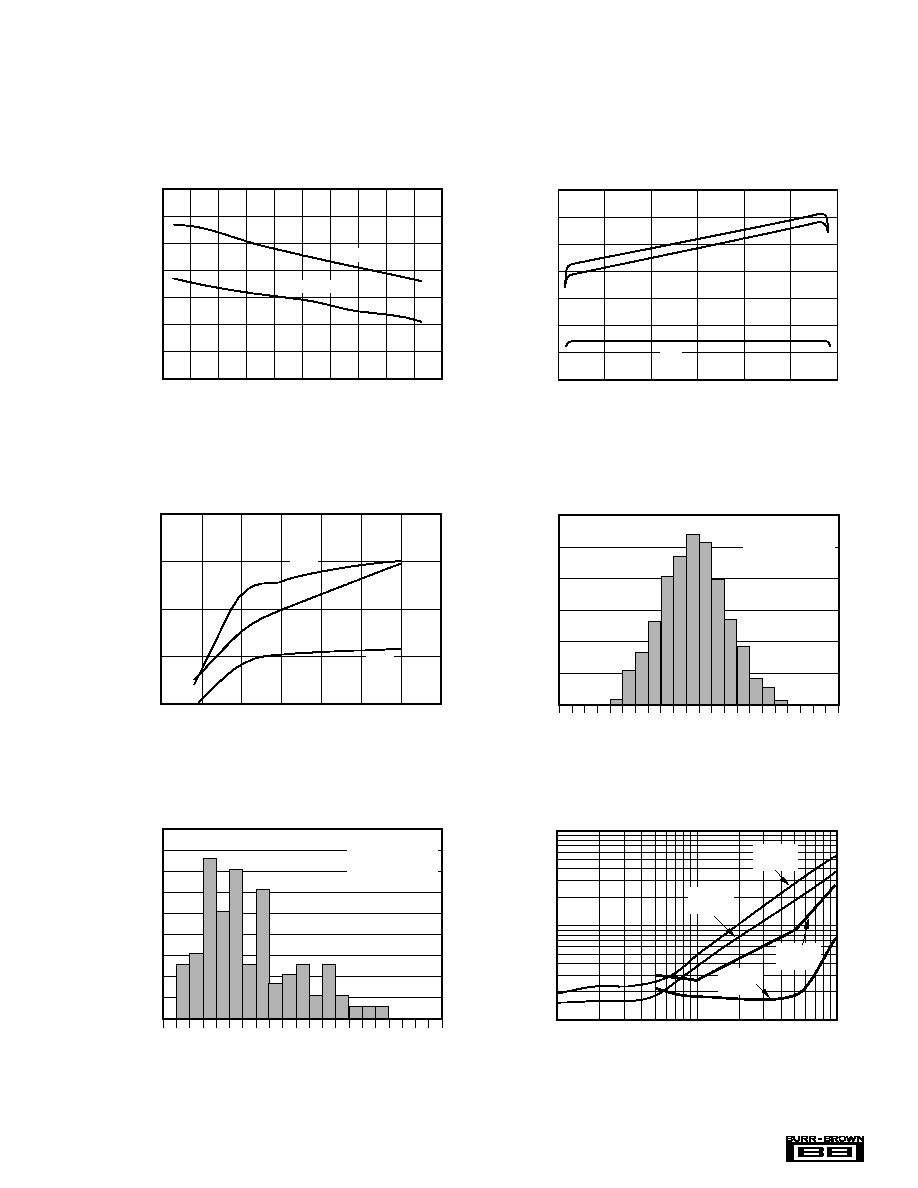
7
OPA551, OPA552
Æ
TYPICAL PERFORMANCE CURVES
(Cont.)
At T
J
= +25
∞
C, V
S
=
±
30V and R
L
= 3k
, unless otherwise noted.
All temperatures are junction temperatures unless otherwise noted. Refer to the Applications Information section to calculate junction temperatures from ambient
temperatures for a specific configuration.
35
30
25
20
15
10
5
0
≠60
≠40
≠20
0
20
40
60
80
100
120
140
Junction Temperature (
∞
C)
Slew Rate (V/
µ
s)
SLEW RATE vs TEMPERATURE
OPA551
OPA552
30
25
20
15
10
5
0
≠5
≠30
≠20
≠10
0
10
20
30
Common-Mode Voltage (V)
Current (pA)
INPUT BIAS CURRENT AND INPUT OFFSET CURRENT
vs COMMON-MODE VOLTAGE
+I
B
≠I
B
I
OS
OFFSET VOLTAGE
PRODUCTION DISTRIBUTION
Percent of Amplifiers (%)
Offset Voltage (mV)
< ≠3.0
< ≠2.4
< ≠1.8
< ≠1.2
< ≠0.6
< 0.0
< 0.6
< 1.2
< 1.8
< 2.4
< 3.0
18
15
12
9
6
3
0
Typical production
distribution of
packaged units.
OFFSET VOLTAGE DRIFT
PRODUCTION DISTRIBUTION
Percent of Amplifiers (%)
Offset Drift
µ
V/
∞
C
< 0.0
< 1.5
< 3.0
< 4.50
< 6.0
< 7.5
< 9.0
< 10.5
< 12.0
< 13.5
< 15.0
18
16
14
12
10
8
6
4
2
0
Typical production
distribution of
packaged units.
100
10
1
1
10
100
Gain (V/V)
Settling Time (
µ
s)
SETTLING TIME vs CLOSED-LOOP GAIN
OPA551
0.1%
OPA552
0.01%
OPA552
0.1%
OPA551
0.01%
7.6
7.2
6.8
6.4
6.0
405
395
385
375
365
0
5
10
15
20
25
30
35
Supply Voltage (V)
Quiescent Current (mA)
Short-Circuit Current (mA)
QUIESCENT CURRENT AND SHORT-CIRCUIT CURRENT
vs SUPPLY VOLTAGE
I
Q
+I
SC
≠I
SC
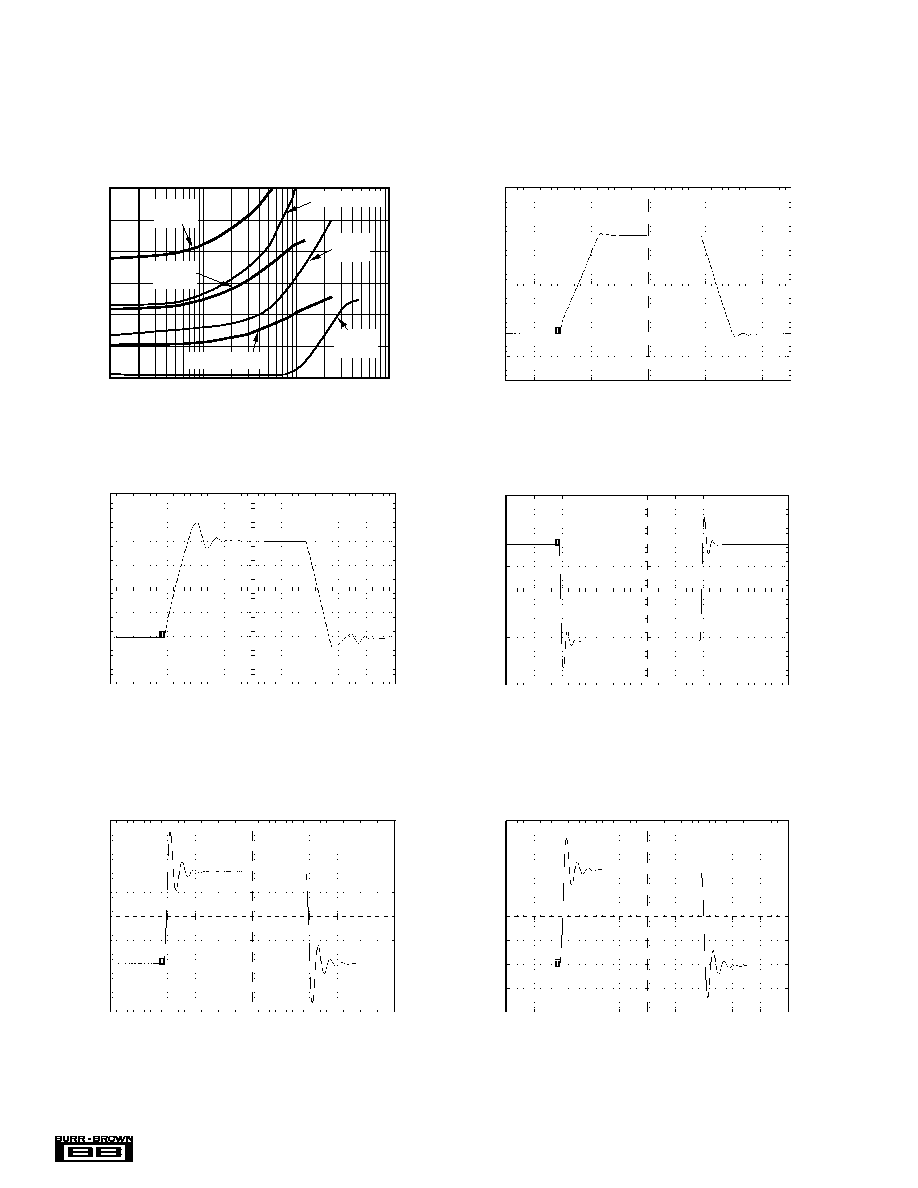
8
OPA551, OPA552
Æ
TYPICAL PERFORMANCE CURVES
(Cont.)
At T
J
= +25
∞
C, V
S
=
±
30V and R
L
= 3
, unless otherwise noted.
All temperatures are junction temperatures unless otherwise noted. Refer to the Applications Information section to calculate junction temperatures from ambient
temperatures for a specific configuration.
SMALL-SIGNAL STEP RESPONSE
OPA552, G = 5, C
L
= 100pF
Time (1
µ
s/div)
100mV/div
SMALL-SIGNAL STEP RESPONSE
OPA551, G = ≠1, C
L
= 1000pF
Time (1
µ
s/div)
5V/div
LARGE-SIGNAL STEP RESPONSE
OPA552, G = 5, C
L
= 100pF
Time (1
µ
s/div)
5V/div
SMALL-SIGNAL STEP RESPONSE
OPA551, G = 1, C
L
= 100pF
Time (1
µ
s/div)
LARGE-SIGNAL STEP RESPONSE
OPA551, G = 1, C
L
= 100pF
Time (1
µ
s/div)
5V/div
25mV/div
60
50
40
30
20
10
0
0.01
1
0.1
10
Load Capacitance (nF)
Overshoot (%)
SMALL-SIGNAL OVERSHOOT vs LOAD CAPACITANCE
OPA551, G = 1
OPA551
G = ≠2
OPA551
G = ≠1
OPA552
G = ≠4
OPA552
G = ≠6
OPA552, G = ≠8
OPA552
OPA552
OPA551
OPA551
OPA551
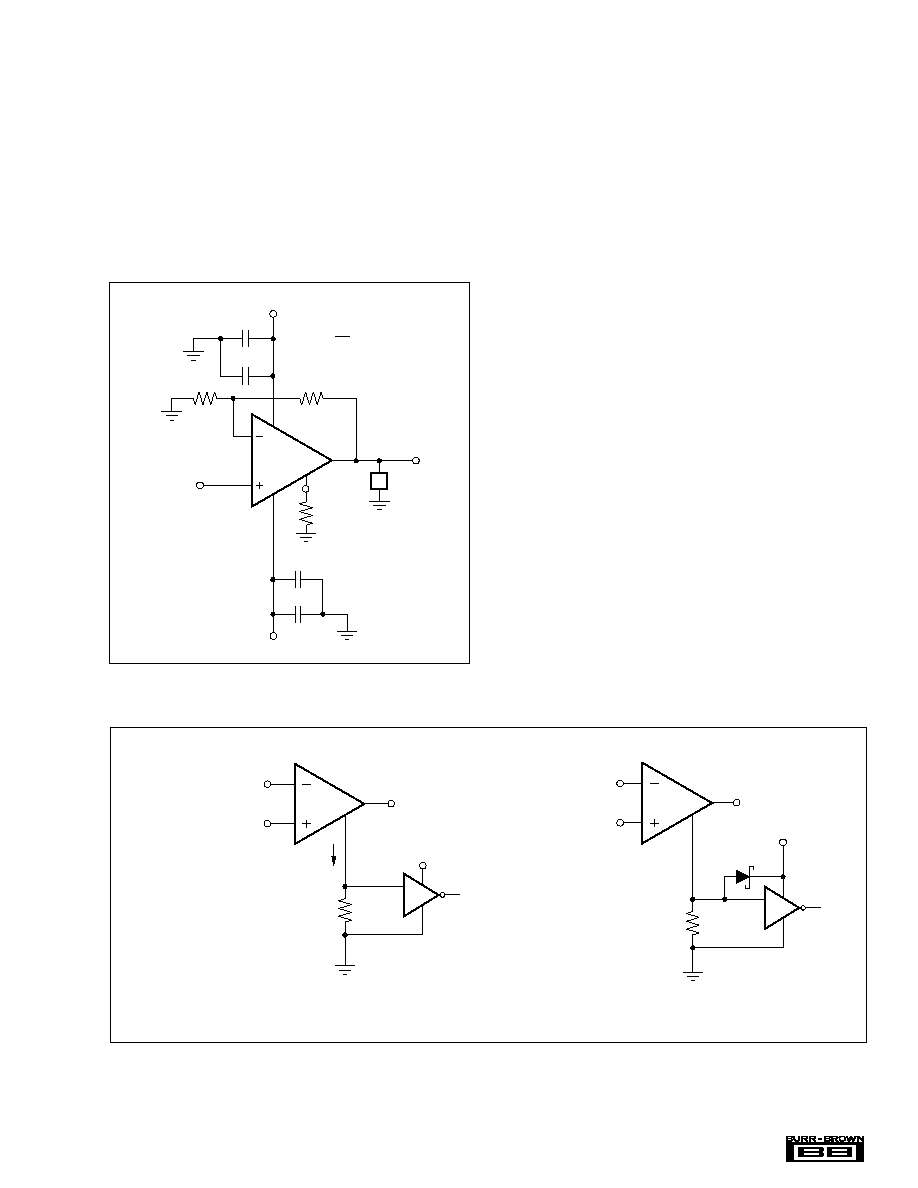
9
OPA551, OPA552
Æ
APPLICATIONS INFORMATION
Figure 1 shows the OPA551 connected as a basic non-
inverting amplifier. The OPA551 can be used in virtually
any op amp configuration. OPA552 is designed for use in
configurations with gains of 5 or greater. Power supply
terminals should be bypassed with 0.1
µ
F capacitors, or
greater, near the power supply pins. Be sure that the capaci-
tors are appropriately rated for the power supply voltage
used. The OPA551 and OPA552 can supply output currents
up to 200mA with excellent performance.
FIGURE 1. Basic Circuit Connections.
CURRENT LIMIT
The OPA551 and OPA552 are designed with internal cur-
rent-limiting circuitry that limits the output current to ap-
proximately 380mA. The current limit varies with increasing
junction temperature as shown in the typical curve "Current
Limit vs Temperature." This, in combination with the ther-
mal protection circuitry, provides protection from many
types of overload conditions including short circuit to ground.
THERMAL PROTECTION
The OPA551 and OPA552 have thermal shutdown circuitry
that protects the amplifier from damage caused by overload
conditions. The thermal protection circuitry disables the
output when the junction temperature reaches approximately
160
∞
C, allowing the device to cool. When the junction
temperature cools to approximately 140
∞
C, the output cir-
cuitry is automatically re-enabled.
The thermal shutdown function is not intended to replace
proper heat sinking. Activation of the thermal shutdown
circuitry is an indication of excessive power dissipation or
an inadequate heat sink. Continuously running the amplifier
into thermal shutdown can degrade reliability.
The Thermal Shutdown Indicator ("flag") pin can be moni-
tored to determine if shutdown is occurring. During normal
operation, the current output from the flag pin is typically
50nA. During shutdown, the current output from the flag pin
increases to 120
µ
A (typical). This current output allows for
easy interfacing to external logic. See Figure 2 for two
examples implementing this function.
FIGURE 2. Thermal Shutdown Indicator.
G = 1+
R
2
R
1
Z
L
R
2
R
1
0.1
µ
F
10
µ
F
OPA551
V≠
V+
+
+
V
IN
10
µ
F
0.1
µ
F
V
O
Flag
(optional)
Flag
80
µ
A to
160
µ
A
HCT
OPA551
Logic
Ground
V
OUT
+5V
27k
V
LOGIC
V
OUT
CMOS
OPA551
Logic
Ground
Interfacing with CMOS Logic
Interfacing with HCT Logic
47k
HP5082-2835
Interface to virtually any CMOS
logic gate by choosing resistor
value that provides a guaranteed
logic high voltage with the
minimum (80
µ
A) flag current. A
diode clamp to the logic supply
voltage assures that the CMOS
is not damaged by overdrive.
HCT logic has relatively well-
controlled logic level. A properly
chosen resistor value can
guarantee proper logic high level
throughout the full range of flag
output current.

10
OPA551, OPA552
Æ
POWER SUPPLIES
The OPA551 and OPA552 may be operated from power
supplies of
±
4V to
±
30V, or a total of 60V with excellent
performance. Most behavior remains unchanged throughout
the full operating voltage range. Parameters that vary sig-
nificantly with operating voltage are shown in the Typical
Performance Curves.
For applications that do not require symmetrical output
voltage swing, power supply voltages do not need to be
equal. The OPA551 and OPA552 can operate with as little
as 8V between the supplies or with up to 60V between the
supplies. For example, the positive supply could be set to
50V with the negative supply at ≠10V or vice-versa.
The SO-8 package outline shows three negative supply (V≠)
pins. These pins are internally connected for improved thermal
performance. Pin 4 is to be used as the primary current
carrier for the negative supply. It is recommended that
pins 1 and 5 not be directly connected to V≠ but, instead
be connected to a thermal mass. DO NOT lay out the PC
board to use pins 1 and 5 as feedthroughs to the negative
supply. Doing so can result in a reduction of performance.
The tab of the DDPAK-7 package is electrically connected
to the negative supply (V≠), however, this connection should
not be used to carry current. For best thermal performance,
the tab should be soldered directly to the circuit board
copper area (see heat sink text).
POWER DISSIPATION
Internal power dissipation of these op amps can be quite
large. Many of the specifications for the OPA551 and
OPA552 are for a specified junction temperature. If the
device is not subjected to internal self-heating, the junction
temperature will be the same as the ambient. However, in
practical applications, the device will self-heat and the junc-
tion temperature will be significantly higher than ambient.
After junction temperature has been established, perfor-
mance parameters that vary with junction temperature can be
determined from the performance curves. The following
calculation can be performed to establish junction tempera-
ture as a function of ambient temperature and the conditions
of the application.
Consider the OPA551 in a circuit configuration where the
load is 600
and the output voltage is 15V. The supplies are
at
±
30V and the ambient temperature (T
A
) is 40
∞
C. The
JA
for the 8-pin DIP package is 100
∞
C/W.
First, the internal heating of the op amp is as follows:
P
D(internal)
= I
Q
∑ V
S
= 7.2mA ∑ 60V = 432mW
The output current (I
O
) can be calculated:
I
O
= V
OUT
/ R
L
= 15V / 600
= 25mA
The power being dissipated (P
D
) in the output transistor of
the amplifier can be calculated:
P
D(output stage)
= I
O
∑ (V
S
≠ V
O
) = 25mA ∑ (30 ≠ 15) = 375mW
P
D(total)
= P
D(internal)
+ P
D(output stage)
= 432mW + 375mW = 807mW
The resulting junction temperature can be calculated:
T
J
= T
A
+ P
D
JA
T
J
= 40
∞
C + 807mW ∑ 100
∞
C/W = 120.7
∞
C
Where,
T
J
= junction temperature (
∞
C)
T
A
= ambient temperature (
∞
C)
JA
= junction-to-air thermal resistance (
∞
C/W)
For the DDPAK package, the
JA
is 65
∞
C/W with no heat
sinking, resulting in a junction temperature of 92.5
∞
C.
To estimate the margin of safety in a complete design
(including heat sink), increase the ambient temperature until
the thermal protection is activated. Use worst-case load and
signal conditions. For good reliability, the thermal protec-
tion should trigger more than +35
∞
C above the maximum
expected ambient condition of your application. This en-
sures a maximum junction temperature of +125
∞
C at the
maximum expected ambient condition.
If the OPA551 or OPA552 is to be used in an application
requiring more than 0.5W continuous power dissipation, it
is recommended that the DDPAK package option be used.
The DDPAK has superior thermal dissipation characteris-
tics and is more easily adapted to a heat sink.
Operation from a single power supply (or unbalanced power
supplies) can produce even larger power dissipation since a
larger voltage can be impressed across the conducting output
transistor. Consult Application Bulletin AB-039 for further
information on how to calculate or measure power dissipation.
Power dissipation can be minimized by using the lowest
possible supply voltage. For example, with a 200mA load,
the output will swing to within 3.5V of the power supply
rails. Power supplies set to no more than 3.5V above the
maximum output voltage swing required by the application
will minimize the power dissipation.
SAFE OPERATING AREA
The Safe Operating Area (SOA curves, Figures 3, 4, and 5)
shows the permissible range of voltage and current. The
curves shown represent devices soldered to a circuit board
with no heat sink. The safe output current decreases as the
voltage across the output transistor (V
S
≠ V
O
) increases. For
further insight on SOA, consult Application Bulletin AB-039.
Output short circuits are a very demanding case for SOA.
A short circuit to ground forces the full power supply
voltage (V+ or V≠) across the conducting transistor and
produces a typical output current of 380mA. With
±
30V
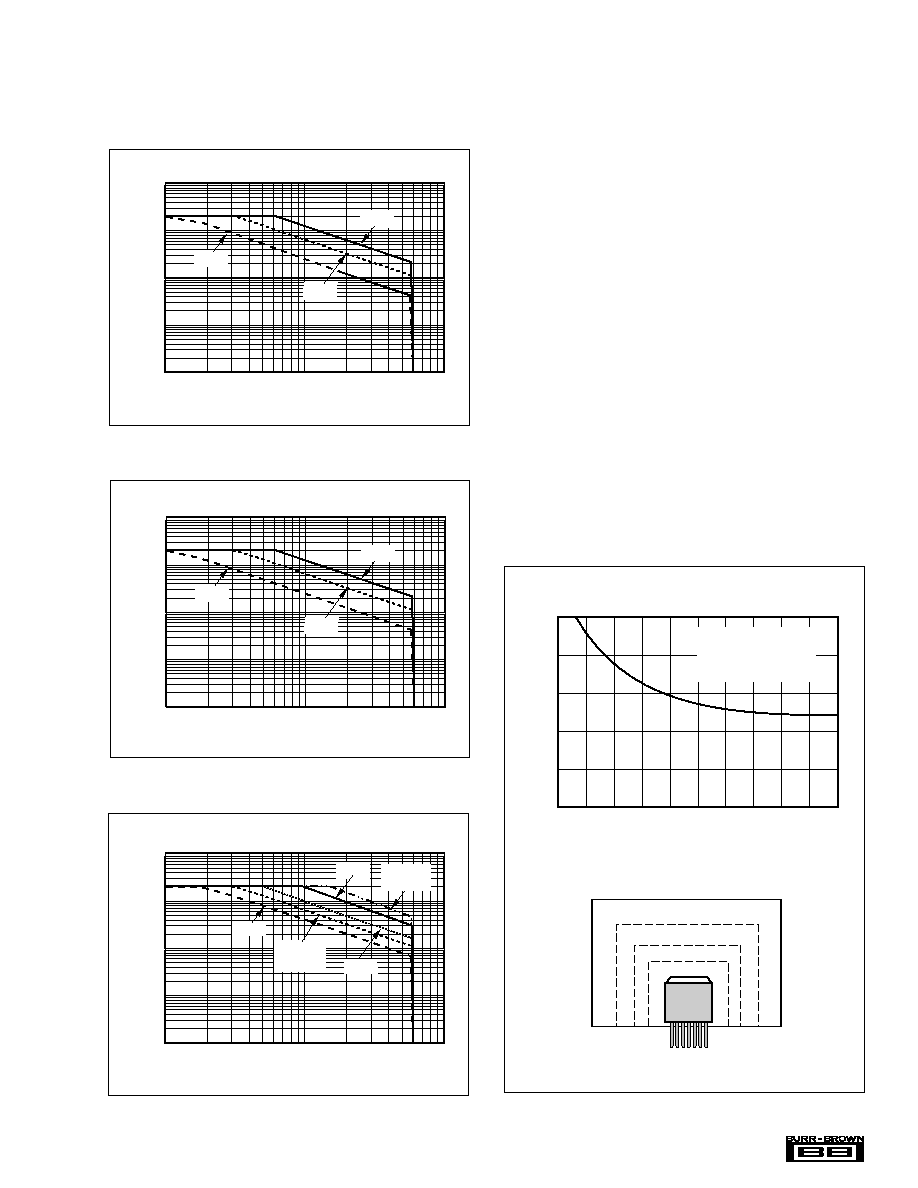
11
OPA551, OPA552
Æ
power supplies, this creates an internal dissipation of 11.4W.
This far exceeds the maximum rating and is not recom-
mended. If operation in this region is unavoidable, use the
DDPAK with a heat sink.
HEAT SINKING
Power dissipated in the OPA551 or OPA552 will cause the
junction temperature to rise. For reliable operation, the
junction temperature should be limited to +125
∞
C. Many
applications will require a heat sink to assure that the
maximum operating junction temperature is not exceeded.
The heat sink required depends on the power dissipated and
on ambient conditions.
For heat sinking purposes, the tab of the DDPAK is typically
soldered directly to a circuit board copper area. Increasing
the copper area improves heat dissipation. Figure 6 shows
typical thermal resistance from junction-to-ambient as a
function of copper area.
Depending on conditions, additional heat sinking may be
required. Aavid Thermal Products Inc. manufactures sur-
face-mountable heat sinks designed specifically for use with
DDPAK packages. Further information is available on
Aavid's web site, www.aavid.com.
To estimate the margin of safety in a complete design
(including heat sink), increase the ambient temperature until
the thermal protection is activated. Use worst-case load and
signal conditions. For good reliability, the thermal protec-
tion should trigger more than +25
∞
C above the maximum
expected ambient condition of your application. This pro-
duces a junction temperature of +125
∞
C at the maximum
expected ambient condition.
FIGURE 5. DDPAK-7 Safe Operating Area.
FIGURE 3. DIP-8 Safe Operating Area.
FIGURE 4. SO-8 Safe Operating Area.
FIGURE 6. DDPAK Thermal Resistance vs Circuit Board
Copper Area.
THERMAL RESISTANCE vs
CIRCUIT BOARD COPPER AREA
50
40
30
20
10
0
0
1
2
3
4
5
Copper Area (inches
2
)
OPA551, OPA552
Surface-Mount Package
1oz. copper
Circuit Board Copper Area
OPA551, OPA552
Surface-Mount Package
Thermal Resistance,
JA
(
∞
C/W)
1000
100
10
1
0.1
1
10
100
| V
S
| ≠ | V
O
| (V)
I
O
(mA)
SAFE OPERATING AREA--8-PIN DIP
125
∞
C
85
∞
C
25
∞
C
1000
100
10
1
0.1
1
10
100
| V
S
| ≠ | V
O
| (V)
I
O
(mA)
SAFE OPERATING AREA--SO-8
125
∞
C
85
∞
C
25
∞
C
1000
100
10
1
0.1
1
10
100
| V
S
| ≠ | V
O
| (V)
I
O
(mA)
SAFE OPERATING AREA--DDPAK
125
∞
C
125
∞
C
1" Copper
85
∞
C
25
∞
C
25
∞
C
1" Copper
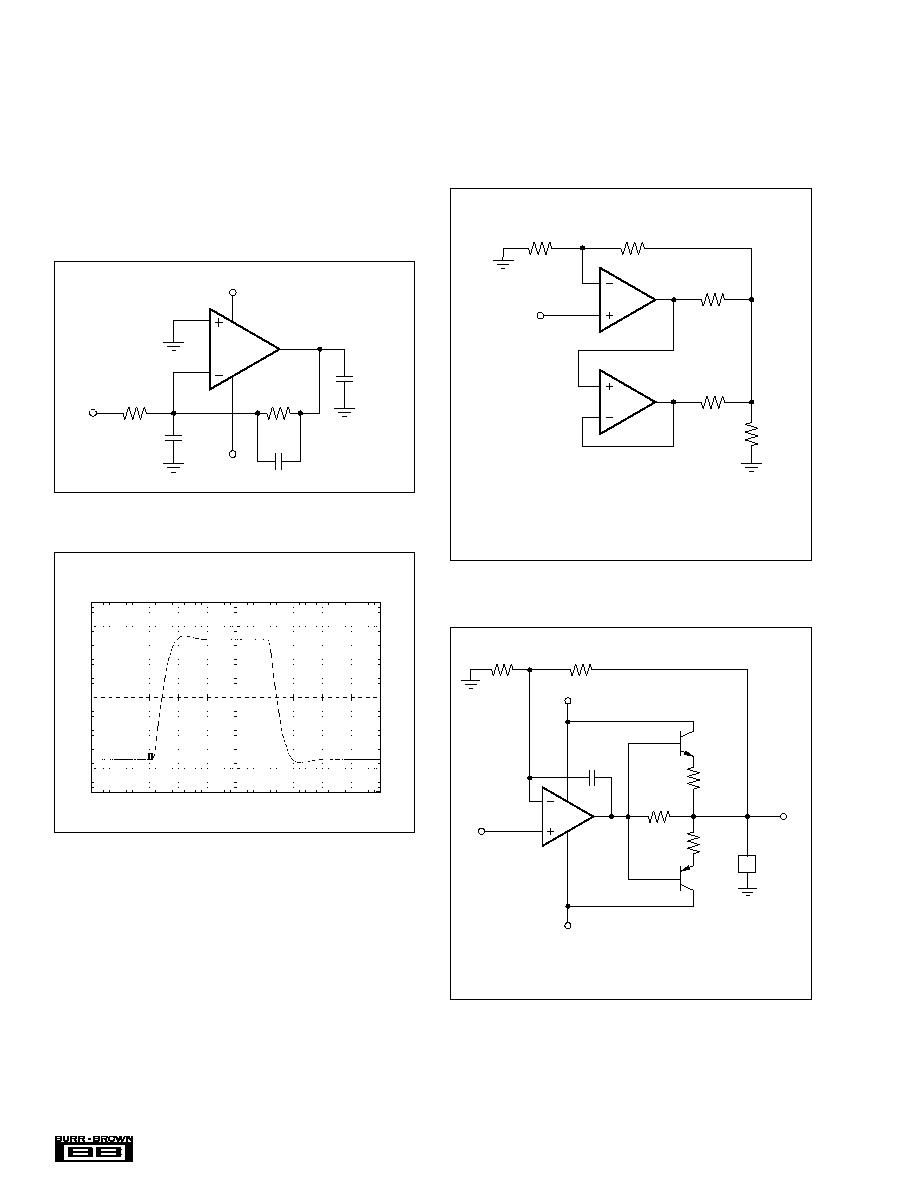
12
OPA551, OPA552
Æ
FIGURE 7. Driving Large Capacitive Loads.
CAPACITIVE LOADS
The dynamic characteristics of the OPA551 and OPA552
have been optimized for commonly encountered gains, loads,
and operating conditions. The combination of low closed-
loop gain and capacitive load will decrease the phase margin
and may lead to gain peaking or oscillations. Figure 7 shows
a circuit that preserves phase margin with capacitive load.
Figure 8 shows the small-signal step response for the circuit
in Figure 7. Consult Application Bulletin AB-028 for more
information.
FIGURE 8. Small-Signal Step Response for Figure 7.
SMALL-SIGNAL STEP RESPONSE
OPA551, G = ≠1, C
L
= 10nF
Time (2.5
µ
s/div)
20mV/div
FIGURE 9. Parallel Amplifers Increase Output Current Ca-
pability.
INCREASING OUTPUT CURRENT
In those applications where the 200mA of output current is
not sufficient to drive the desired load, output current can be
increased by connecting two or more OPA551s or OPA552s
in parallel as shown in Figure 9. Amplifier A1 is the
"master" amplifier and may be configured in virtually an op
amp circuit. Amplifier A2, the "slave", is configured as a
unity gain buffer. Alternatively, external output transistors
can be used to boost output current. The circuit in Figure 10
is capable of supplying output currents up to 1A. Alterna-
tively, the OPA547, OPA548, and OPA549 series power op
amps should be considered for high output current drive,
along with programmable current limit and output disable
capability.
FIGURE 10. External Output Transistors Boost Output Cur-
rent Up to 1 Amp.
R
F
4k
C
S
1.8nF
10nF
OPA551
+30V
≠30V
V
I
C
F
220pF
R
G
4k
R
1
R
2
OPA551
OPA551
"SLAVE"
"MASTER"
V
IN
R
S
(1)
10
R
S
(1)
10
R
L
NOTE: (1) R
S
resistors minimize the circulating
current that can flow between the two devices
due to V
OS
errors.
R
1
R
2
OPA551
TIP30C
TIP29C
V
IN
+30V
≠30V
V
O
R
3
(1)
100
NOTE: (1) R
3
provides current limit and allows the amplifier to
drive the load when the output is between 0.7V and ≠0.7V.
R
4
0.2
R
4
0.2
LOAD
C
F
OPA551

13
OPA551, OPA552
Æ
INPUT PROTECTION
The OPA551 and OPA552 feature internal clamp diodes
to protect the inputs when voltages beyond the supply rails
are encountered. However, input current should be limited
to 5mA. In some cases, an external series resistor may be
required. Many input signals are inherently current-limtied,
therefore, a limiting resistor may not be required. Please
consider that a "large" series resistor, in conjunction with
the input capacitance, can affect stability.
USING THE OPA552 IN LOW GAINS
The OPA552 family is intended for applications with
signal gains of 5 or greater, but it is possible to take
advantage of their high slew rate in lower gains using an
external compensation technique in an inverting configu-
ration. This technique maintains low noise characteristics
of the OPA552 architecture at low frequencies. Depending
on the application, a small increase in high frequency
noise may result. This technique shapes the loop gain for
good stability while giving an easily controlled second-
order low-pass frequency response.
Considering only the noise gain (non-inverting signal
gain) for the circuit of Figure 11, the low frequency noise
gain (NG
1
) will be set by the resistor ratios, while the high
frequency noise gain (NG
2
) will be set by the capacitor
ratios. The capacitor values set both the transition fre-
quencies and the high frequency noise gain. If this noise
gain, determined by NG
2
= 1 + C
S
/C
F
, is set to a value
greater than the recommended minimum stable gain for
the op amp and the noise gain pole, set by 1/R
F
C
F
, is
placed correctly, a very well controlled, 2nd-order low-
pass frequency response will result.
To choose the values for both C
S
and C
F
, two parameters
and only three equations need to be solved. First, the
target for the high frequency noise gain (NG
2
) should be
greater than the minimum stable gain for the OPA552. In
the circuit in Figure 11, a target NG
2
of 10 is used.
Second, the signal gain of ≠1 shown in Figure 11 sets the
low frequency noise gain to NG
1
= 1 + R
F
/R
G
(=2 in this
example). Using these two gains, knowing the Gain Band-
width Product (GBP) for the OPA552 (12MHz), and
targeting a maximally flat 2nd-order, low-pass Butterworth
frequency response (Q = 0.707), the key frequency in the
compensation can be found.
For the values shown in Figure 11, the f
≠3dB
will be
approximately 956kHz. This is less than that predicted by
simply dividing the GBP by NG
1
. The compensation
network controls the bandwidth to a lower value while
providing the full slew rate at the output and an excep-
tional distortion performance due to increased loop gain at
frequencies below NG
1
∑ Z
0
. The capacitor values shown
in Figure 11 are calculated for NG
1
= 2 and NG
2
= 10 with
no adjustment for parasitics.
Actual circuit values can be optimized by check the
small-signal step response with actual load conditions.
Figure 12 shows the small-signal step response of this
OPA552, G = ≠1 circuit with a 500pF load. It is well-
behaved with no tendency to oscillate. If C
S
and C
F
were
removed, the circuit would be unstable.
FIGURE 11. Compensation of the OPA552 for G = 1.
FIGURE 12. Small-Signal Step Response for Figure 11.
SMALL-SIGNAL STEP RESPONSE
OPA552, G = ≠1, C
L
= 500pF
Time (1
µ
s/div)
20mV/div
R
F
1k
C
S
1.88nF
NG
1
= 1 + R
F
/R
G
= 2
NG
2
= 1 + C
S
/C
F
= 10
OPA552
+30V
≠30V
V
IN
V
OUT
C
F
208pF
R
G
1k
OPA552

14
OPA551, OPA552
Æ
The offset voltage (V
OS
) of the OPA51 and OPA552 is
specified with a
±
30V power supply and the common-
mode voltage centered between the supplies (V
S
/2 =
0V). Additional specifications for power supply rejec-
tion and common-mode rejection are provided to allow
the user to easily calculate worst-case excepted offset
under the conditions of a given application.
Power Supply Rejection Ratio (PSRR) is specified in
µ
V/V. For the OPA551 and OPA552, worst-case PSRR
is 30
µ
V/V, which means for each volt of change in total
power supply voltage, the offset may shift by up to
30
µ
V/V. Common-Mode Rejection Ratio (CMRR) is
specified in dB, which can be converted to
µ
V/V using
the following equation:
CMRR in (V/V) = 10
[(CMRR in dB)/≠20]
(1)
For the OPA551 and OPA552, the worst-case CMRR at
±
30mV supply over the full common-mode range is
96dB, or approxmately 15.8
µ
V/V. This means that for
every volt of change in common-mode, the offset may
shift up to 15.8
µ
V. These numbers can be used to
OFFSET VOLTAGE ERROR CALCULATION
calculate excursions from the specified offset voltage
under different applications conditions. For example, a
common application might configure the amplifier with
a ≠48 single supply with ≠6V common-mode. This
configuration represents a 12V variation in power sup-
ply:
±
30V or 60V in the offset specification versus 48V
in the application. In addition, this configuration has an
18V variation in common-mode voltage: V
S
/2 = ≠24V is
the specification for these power supplies, but the com-
mon-mode voltage is ≠6V in the application.
Calculation of the worst-case expected offset would be
as follows:
Worst-case V
OS
=
(2)
maximum specified V
OS
+ (power supply variation ∑ PSRR
+ (common-mode variation ∑ CMRR)
V
OSwc
= 5mV + (12V ∑ 30
µ
V/V) + (18V ∑ 15.8
µ
V/V)
=
±
5.64mV













